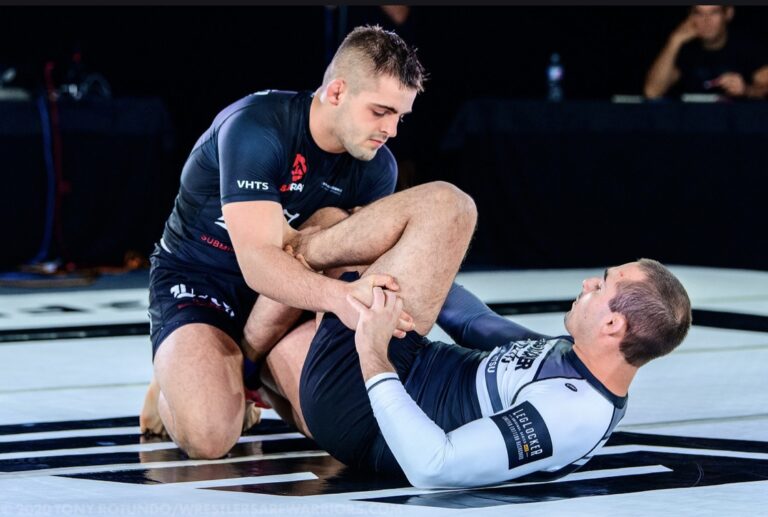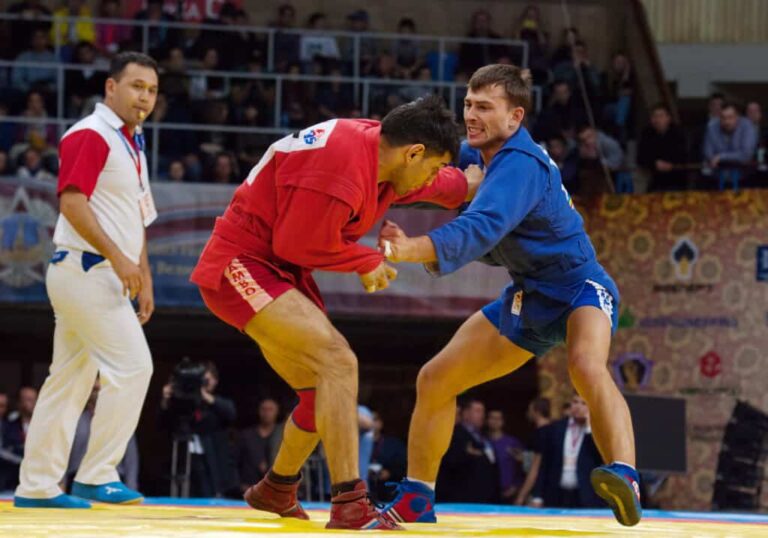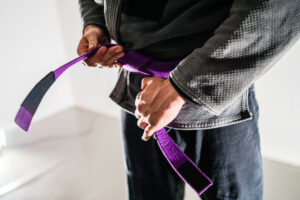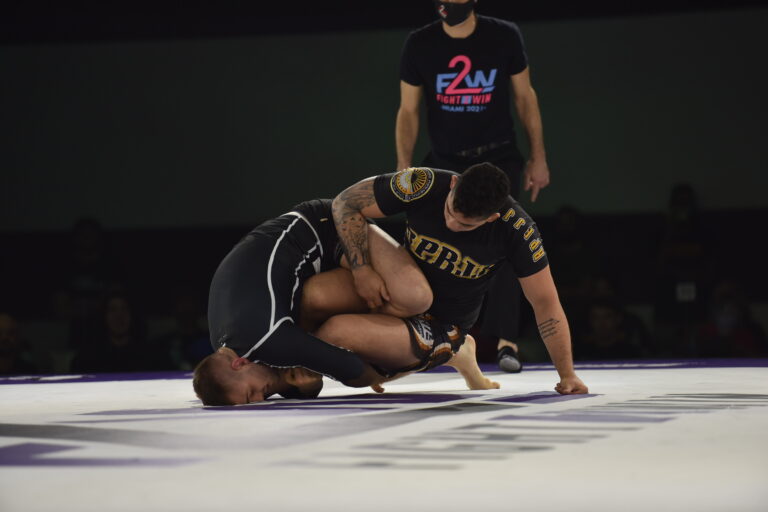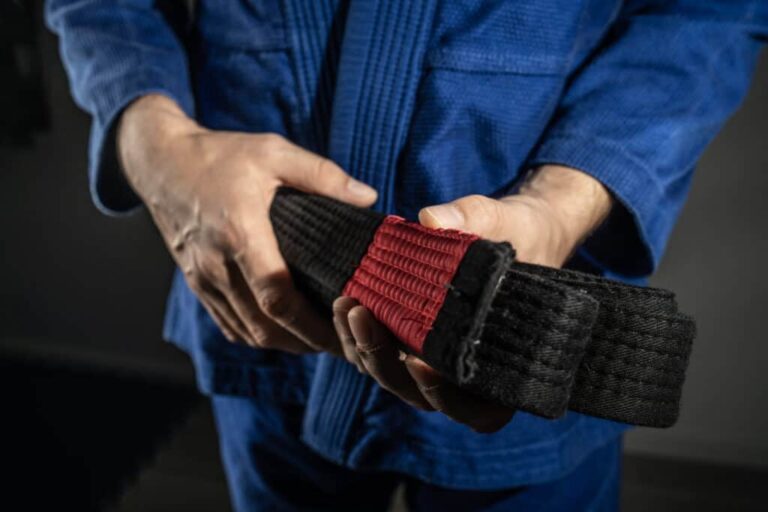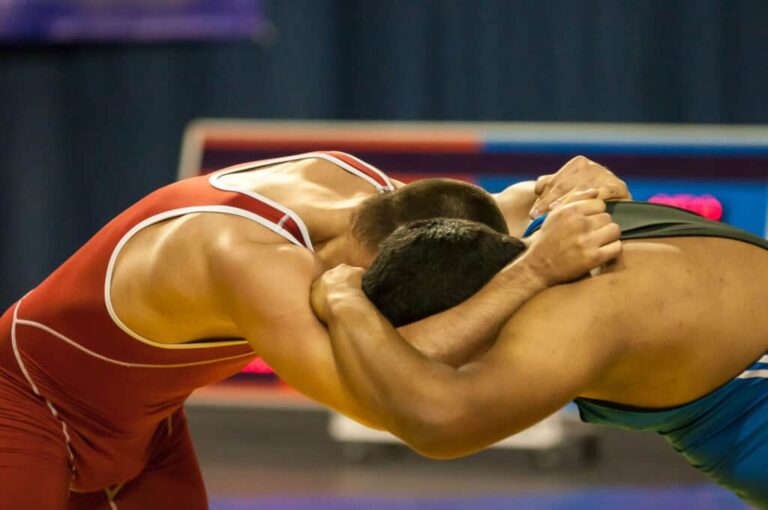Catch Wrestling Vs. BJJ: Differences and Pros and Cons Of Each
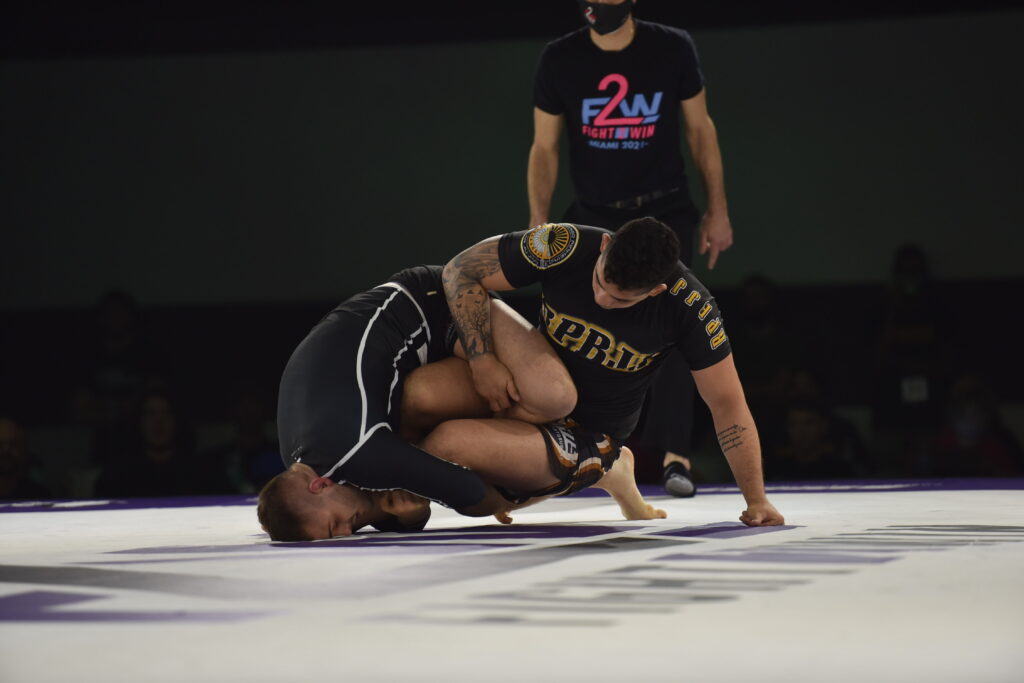
Catch wrestling and BJJ are two popular grappling arts with passionate fans. Some argue that catch wrestling helps to achieve a higher level of fitness than BJJ, while others suggest that BJJ has better techniques and is effective for any combative situation, so who’s right in this battle? Is catch wrestling better than BJJ?
Catch wrestling is neither better nor worse than BJJ. Instead, they are simply different arts and sports with similar yet different goals. Both catch wrestling and BJJ are grappling arts with a major goal of submitting your opponent. Which art is better for you depends on your goals and preferences.
Personally, I believe that it is time we stop arguing about which grappling art is best and start adopting the best techniques from each art. Why limit yourself to one grappling art when there is so much to learn from all of them.
Both catch wrestling and BJJ have great submissions and are very effective grappling arts. Most grapplers would consider catch wrestling to be a much more aggressive and brutal grappling art than BJJ. Jiu-Jitsu on the other hand is known as the gentle grappling art.
In the rest of this article, I’ll show you the specifics and history of both martial arts, the differences and similarities between them, and which one suits your needs better.
Catch Wrestling: A Brief Overview
Catch wrestling is a combat sport that has existed since 1870. It has widespread recognition in grappling and combat sports due to its brutality and aggressive submissions.
It started in a small sports ground in London, by the Welsh sportsman John Graham Chambers. The sport had little support initially but soon gained popularity in Britain when the Cumberland and Westmorland Amateur Wrestling Society was created.
Its popularity spread to the US in the early 20th century when carnival wrestlers extended challenges to the locals as part of the show for a cash reward. The locals had to defeat the carnival’s strong man by either a pin or submission to win the prize.
Unlike other wrestling styles, the only way to win in catch wrestling is by pin or submission. The concept of points in wrestling was something that would not be created until utilized in freestyle, Greco-Roman, and folkstyle wrestling.
Catch Wrestling Techniques
To get their opponent to submit, catch wrestlers use different techniques, some more brutal than others. Here are some of them:
Takedowns
One area that BJJ gets a lot of criticism over is its lack of takedown techniques. After all, how useful is being skilled at ground fighting if you can’t take your opponent to the ground in the first place.
Most BJJ players rely on learning takedowns from judo and wrestling to get their opponent to the ground. Or simply choose to pull guard and play the bottom position.
In catch wrestling, takedowns have been a very important aspect of the sport since day one.
Leg Locks
The leg locks involve holding the leg in positions that limit its movement. It targets different leg joints, such as the knee, hip, ankle, and foot. Each move has a name that corresponds with the locked part. For example, the knee lock targets the knee, and the ankle lock targets the ankle.
This technique can render an opponent relatively immobile. On introducing certain twists, the opponent’s back can get pinned against the floor or submit due to an injury threat to their lower body.
Today many BJJ players ( especially no-gi BJJ players ) have adopted leg locks into their arsenal. That said, at one point in time leg locks were only seen as something to do as a last resort in most BJJ circles.
That said, leg locks have always been a big part of catch wrestling. So you could say that catch wrestling was way ahead of the current leg lock trend going on in BJJ today.
Arm Locks
The arm locks are similar to a leg lock, except that it focuses on the arm. It renders the arm relatively immovable, with the joints being either hyper-flexed or hyper-extended. The move is effective in getting an opponent to submit.
The lock can be applied to different parts of the arm, to create the shoulder lock, wrist lock, hammerlock, and armbar.
Kneebar
The kneebar is a type of leg lock that holds the lower leg in a hyper-extended position. This technique allows a practitioner to keep their opponent’s leg between his legs so that the opponent’s knee cap faces his (the fighter) body.
The fighter then secures the opponent’s leg with his arm and applies pressure with his hips. It hyperextends the knee and is a good submission technique.
Chest Locks
Also called chest choke, the chest lock involves the use of the arm and shoulder, wrapped around an opponent’s head from the hind, with the hips facing their head to hold them in that position.
The aim is submission. It hyperextends the opponent’s spine and bends his head towards you as you apply pressure with your locked arms. It causes breath disruption and will effectively lead to submission if your opponent cannot get out of the hold.
Neck Cranks
Another thing that separates BJJ submissions from catch wrestling submissions is the use of neck cranks. These brutal and painful submissions rely on you cranking the neck of your opponent until they submit. Of course, today many in the no-gi BJJ circles are starting to adopt neck cranks into their arsenal, but it has been part of catch wrestling from the start.
BJJ: A Brief Overview
Popularly called BJJ, Brazilian Jiu-Jitsu is a form of submission grappling or ground fighting that, as the name implies, originated in Brazil through the Gracie family. Today, it is mainly a sport, but it used to be a means of self-defense.
Of course, many schools still mostly focus on self-defense. However, as time goes on more and more academies are putting more focus on the sport of Brazilian Jiu-Jitsu.
Another major difference between BJJ and catch wrestling is that BJJ is practiced in a Gi. Because of this many of the submissions, takedowns, and sweeps rely heavily on the use of the BJJ Gi.
BJJ employs different techniques to help a fighter gain dominance over his opponent on the ground. A fighter typically wins the match when they maintain dominant positions, takedowns, or sweeps that result in points or by submitting their opponent.
In addition, no-gi BJJ is starting to become more and more popular every day. This is simply BJJ but without the traditional gi. Some schools such as 10th Planet have completely dropped the gi altogether.
Many of the no-gi tournaments also have different rules. For example, some tournaments are submission-only tournaments where the player must win by submission. In addition, many no-gi tournaments also allow for more submissions that might be illegal in IBJJF rules.
Techniques and Positions Used in BJJ
Many BJJ techniques may injure the opponent if he fails to submit. Here are some of the techniques.
Sweeps
In regular combat, a sweep refers to an attack on an opponent’s leg to make them lose balance. It is followed by other strikes to get them to the ground. However, in BJJ, a sweep is a technique to escape a bad position and reverse into a dominant position on the floor.
Guard
The guard is useful when a fighter is on his back, and the opponent tries to strike from the top. In this position, the practitioner, with his back to the ground, can use various techniques like joint locks and chokes to attack the opponent. Of course, there are many other positions in BJJ such as side control and mount.
However, the guard separates BJJ from catch wrestling because catch wrestlers do not grapple off their backs. This is because one of the ways to win in catch wrestling is by pinning your opponent’s shoulders to the floor. So naturally, you would never want to go to your back in catch wrestling.
Chokes
Chokes are pretty common in BJJ. They are used to limit or stop blood flow to the brain, thereby causing the fighter to lose consciousness until they tap out in submission. Common chokes include bow and arrow choke, baseball choke, sleeve choke, triangle choke, and arm-triangle choke.
Though originally catch wrestling made use of chokes it is very uncommon today.
Catch Wrestling Vs BJJ: The Major Differences
Catch wrestling and BJJ have multiple differences. Although both focus on getting the opponent to submit, they still very different. Here are some of the main differences:
Submissions
Catch wrestling allows more dangerous techniques such as compression locks, heel hooks, and neck cranks. Fighters have a lower degree of safety during fights to add to the excitement.
On the other hand, many of these submissions are barred in most BJJ competitions, including the ones that involve the spine, ankle, and feet. Likewise, there are many submissions in BJJ that you will not find in catch wrestling.
Many of these submissions would involve the use of the BJJ gi. Obviously, since catch wrestlers do not wear a gi, they do not incorporate any chokes or submissions that involve the use of clothing.
Another difference when it comes to submission between catch wrestling and BJJ is the use of strangles. Though you can find the use of strangles or chokes in catch wrestling’s past, it is not something you will typically find emphasized today. On the other hand, chokes are heavily used in BJJ.
Points and Rules
In catch wrestling, the two fighters have a goal to finish the match as fast as possible. The aim is to get the opponent to submit without focusing on points. You can use brute force and athleticism to defeat your opponent.
Unlike catch wrestling which is rather raw and brutal, technique and positions play a huge role in getting a submission in BJJ. Setting up and getting a submission takes more time. And when you do get it, a win is not guaranteed.
BJJ determines the winner based on the number of dominant positions he has and maintains over his opponent if no submission is achieved. In catch wrestling, submission or pin is the primary goal and determines the winner.
Because you can win by pinning your opponent in catch wrestling you will never see a catch wrestler go to their back. On the other hand, some BJJ players choose to pull guard and fight off of their backs.
Catch Wrestling vs. BJJ: Which One Is Better For You?
After learning about the history and techniques of both martial arts, you’re probably wondering which one is right for you.
Both catch wrestling and BJJ are great sports, and none is better than the other. Of course, that does not mean that one is not better suited for you and your goals.
Catch Wrestling Is More Brutal Than BJJ
Catch wrestling is rawer and more brutal, so it can be challenging to master without the right skill and athleticism. You also need a high pain tolerance if you want to learn catch wrestling.
Instead of grappling and using various techniques to submit the opponent, practitioners try to finish as quickly as possible by employing aggressive submissions.
You’re more likely to find a BJJ tournament or school than a catch wrestling academy. This lack of association also means that coaches can set whatever rules they want, and training typically has no shape.
However, if you want to build your aggression and combat strength, catch wrestling can help you achieve those faster. It tends to be tougher to learn, but it is an excellent self-defense toolset if mastered correctly.
The Major Downside To Catch Wrestling
The main reason that I would probably push more people towards BJJ over catch wrestling is that it is very difficult to find a good catch wrestling school. Of course, if you are lucky enough to have a good school in your area then I would highly suggest that you go and check it out.
The biggest problem with catch wrestling is not how effective it is as a grappling art. Instead, the main problem is the ability to find a good gym with qualified instructors. Unlike BJJ, there is not a catch wrestling gym around every corner of our cities.
Even many major US cities lack even one qualified catch wrestling gym. This does not however mean you cannot learn catch wrestling techniques at all.
There are thankfully some great instructionals and online classes for catch wrestling. I have a whole article on the best Catch wrestling instructionals here!
Of course, this cannot replace learning firsthand from an experienced catch wrestler but it is likely your only choice.
BJJ Is More Forgiving Than Catch Wrestling
BJJ is more forgiving than catch wrestling. If you’re a smaller person, BJJ may be more suitable for you since it revolves around techniques that help smaller and weaker people defend themselves against stronger and bigger opponents.
This is not to say that strength and size do not matter in BJJ. But BJJ does focus more on building your submissions through control and leverage.
BJJ is defined by several sets of rules and takes a more calculated approach to submission. While it also requires a lot of dedication to master, it is not as demanding as catch wrestling. You also get to compete in a lot of tournaments throughout the year.
It is also way easier to find a BJJ school than it is to find a place to learn catch wrestling. If you live in a somewhat populated city in the United States and many other countries you will likely have a BJJ school in your town or city.
Ultimately, the martial art you choose will depend on your needs, build, and individual abilities. If you’re still torn between the two, consider training in both martial arts.
Nothing makes you a better grappler than combining your BJJ techniques with the strength and aggressiveness you build from catch wrestling.
Final Thoughts
BJJ and catch wrestling are both great grappling arts. BJJ is safer, and the risk and techniques are more calculated. Catch wrestling is more brutal, and instead of using an opponent’s strength against them, you have to rely more on your strength to win the match.
Catch wrestling has fewer formal competitions as it lacks a governing body. With BJJ, you will compete in many tournaments throughout the year, and the training process is more formal.
Either way, it is my opinion that you should learn from all grappling arts to become the best grappler or martial artist that you can be.
